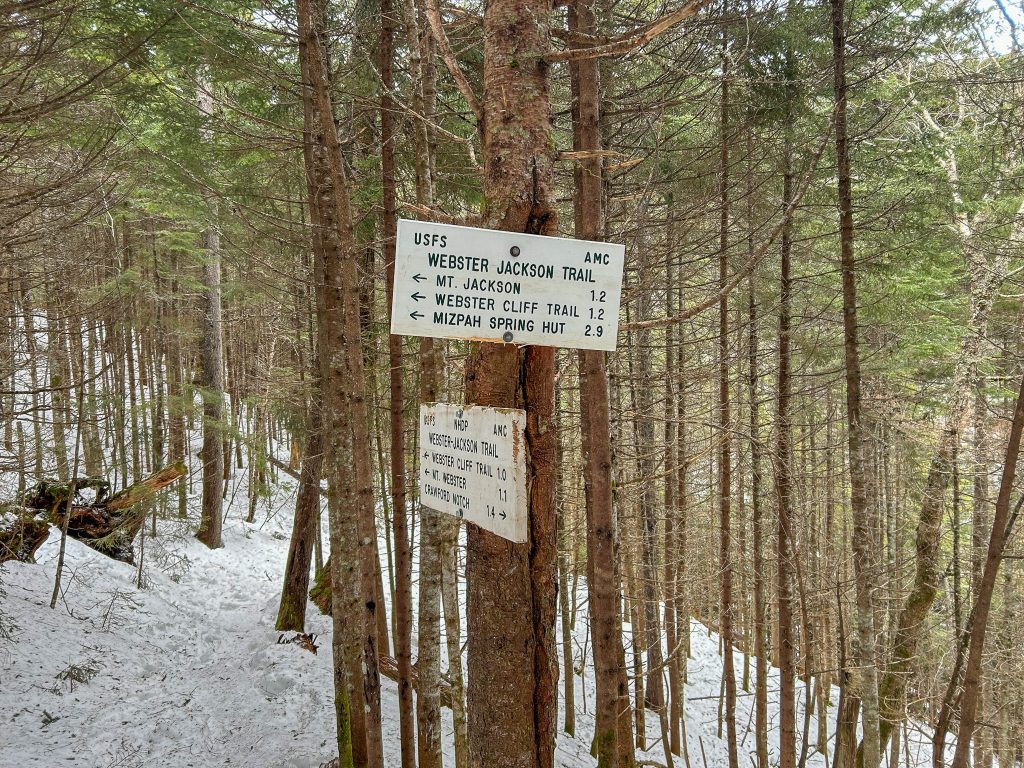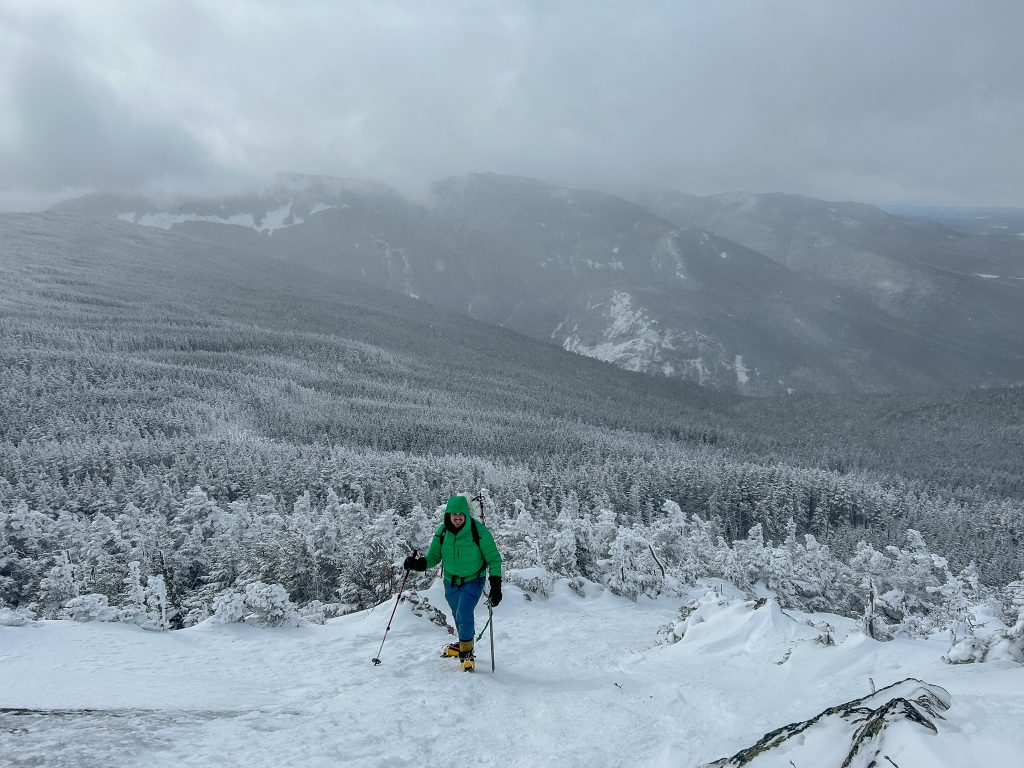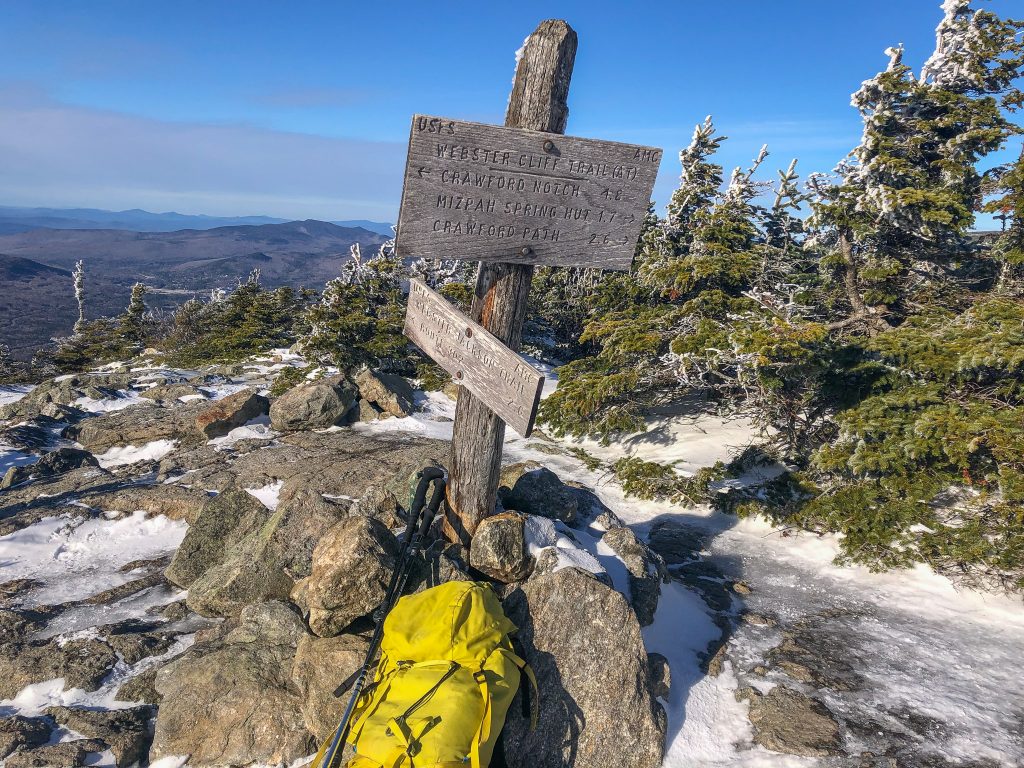A moderate hike with a stellar summit cone and outstanding views makes summiting Mount Jackson during the winter a must-do for every White Mountain hiking enthusiast.
The Webster-Jackson Trail on Mount Jackson is a classic winter hike up a New Hampshire 4,000-footer. At just over five miles, it offers everything hikers want: outstanding views, a taste of the weather in the Presidential Range, and, depending on conditions, a little spice on the final summit push.
Quick Facts
Distance: 5.2 miles round-trip
Time to Complete: Half-day
Difficulty: ★★★
Scenery: ★★★★★
Turn by Turn
A winter hike up Mount Jackson begins and ends on US Route 302 at the AMC Depot at the “top” of Crawford Notch. There is a small lot almost directly across from the trailhead. Once that lot fills up, most pull off and park on the side of Route 302. Just be sure that your parked vehicle does not extend into the travel lanes.
A large sign marks the Webster-Jackson Trailhead. There is a nice flat spot by the sign, and another just in the trees, for putting on your traction devices of choice (MICROspikes, snowshoes, or crampons).

Starting Out
From the trailhead, the Webster-Jackson Trail begins with a steady ascent through forested terrain. Initially, the terrain is stepped—a series of short ascents followed by flatter sections. Follow the rectangular blue blazes up.
Soon hikers will pass the first spur trail, a short path leading to the Elephant Head lookout. Around the half-mile mark, hikers will pass another lookout, this one called Bugle Cliff. From this vantage point, hikers can get a good look at some of the peaks of the Willey Range, which loom large to the west, above US Route 302, as well as the Appalachian Mountain Club’s Crawford House.
Above the lookout, the Webster-Jackson Trail meanders through the forest, gently traversing toward a mellow brook crossing. The trail continues to traverse after the brook, with a gradual incline. To the right, hikers will catch glimpses of Mount Willard, Mount Field, and Mount Willey.
The Split
Near the 1.4-mile mark, the Webster-Jackson Trail splits. The well-signed junction is a great spot to take a break—there’s ample flat ground as well as lots of trees to protect you from the elements. Take a moment here to rehydrate and replenish the calories you’ve burned.
From here, the Webster-Jackson Trail makes a loop over the summits of Mount Jackson and Mount Webster. Hikers seeking the most direct route to Mount Jackson should take the left option for 1.2 miles to the summit.
Above the junction, the Webster-Jackson Trail begins to climb a bit more consistently. Hikers should expect to encounter a few icy segments, especially in low-snow conditions.

The Top Out
The Webster-Jackson Trail steepens again as it approaches Mount Jackson’s summit cone. As it pops above the treeline, the trail makes a sharp right turn, traversing what’s typically an icy slab before turning left and making a beeline up an open rock face to the top. From here, walk east briefly to Mount Jackson’s summit cairn.
On clear days, the views from atop Mount Jackson are incredible. Mount Washington, Mount Monroe, Mount Eisenhower, and Oakes Gulf loom to the north while the Pemigewasset Wilderness spills out to the west, with the three main summits of the Willey Range (Willey, Field, and Tom) in the foreground, the Bonds in the middle, and the jagged white peaks of Franconia Ridge in the distance.
Enjoy your time on the summit, if the weather allows. Often the biting west wind makes an extended stay above treeline a bit chilly, prompting many a hiker to retreat to the more sheltered confines a couple hundred yards back down the trail.
Options Galore
Hikers submitting Mount Jackson have several options once they bag the summit. The most straightforward is to retrace your steps for 2.6 miles back to the trailhead. After the descent off the summit cone, the remainder of the hike is usually well-protected from the elements.
Hikers looking for a bigger day can add to the descent by continuing along the Webster-Jackson Trail, first crossing Mount Webster and then looping back to the junction at the 1.4-mile mark. Although descending this way is only about 2.3 miles, since this section of trail is comparatively less traveled during the winter, be mindful that you’ll likely want snowshoes for it, especially if there’s a deep snowpack.
For those looking to bag another 4,000-footer, consider heading north on the Webster Cliff Trail toward Mount Pierce. Although not always broken in, this 2.4-mile ridgeline traverse gradually descends to the Mitzpah Hut (closed in winter) before climbing to the summit of Mount Pierce. From Pierce, hikers can descend the Crawford Path for 3.2 miles back to US Route 302 and then make a short road walk back to their vehicle. In good conditions, this makes for an excellent 8.5ish-mile loop hike; just beware of icy sections on the traverse between Jackson and Pierce.

The Kit for Hiking Mount Jackson in Winter
- A warm down or synthetic parka like the EMS Featherpack (men’s/women’s) is great for staying warm during rest breaks, the chilly summit cone traverse, and emergencies. On super-cold days, you can even wear it for the descent back to the treeline (and below).
- Because it gets dark quickly in the winter, add a headlamp like the powerful and rechargeable Black Diamond Spot 400 to your pack.
- In low snow conditions, the ascent and descent of the top section of Mount Jackson can be quite icy and can max out your MICROspikes. A hiking/mountaineering crampon like the Black Diamond Sabretooth Crampon can provide some much-needed traction.
- There are plenty of great views atop Mount Jackson, but all the good seats are usually covered with snow and ice. The EMS Siesta Folding Sit Pad is a small, lightweight addition to your pack that ensures you’ll always have a dry and comfy seat.
- Even though most of a hike up Jackson is in the trees, the sun’s reflection off the snow can be bright. Sunglasses are a key piece to keep the glare at bay.
Have more questions about what gear to bring? Check out What’s in Our Winter Peak Bagging Packs for the skinny on everything from layers to accessories to first aid.

Keys to the Trip
- Start cold so you won’t have to stop after 10 minutes to lose a layer. More importantly, if you’re not over-layered, you’re less likely to sweat through your layers, keeping you warmer in the long run.
- Know when to say when. If you start the hike and decide that it’s too windy, too cold, or you just have a bad feeling, don’t hesitate to turn around.
- Mount Jackson is a popular hike, and it’s reasonable to expect that hikers will have packed an excellent track from trailhead to summit. That said, the packed track is typically pretty narrow, and using trekking poles is a great way to avoid accidentally stepping off the path into the deeper snowpack.
- Five miles might not seem like much, but you’ll still work up an appetite. Fortunately, there’s a plethora of stellar White Mountain brew pubs in close proximity to the trailhead. Don’t forget your EMS Ice Box (10L, 20L) to keep the cans you’re sure to purchase cold on the drive home.
Looking for more winter hikes in the Granite State? Check out goEast’s Alpha Guides to two other nearby hikes: Franconia Ridge and Mount Garfield.
Douglas Martland
Doug is an avid skier, climber, and runner. In his spare time, he guides for the EMS Climbing School and is certified as an AMGA Single Pitch Instructor. He also claims the very unofficial record for most known laps on his favorite moderate routes at his home crag, the Quincy Quarries’ White and Black Knight.
Related Posts
April 12, 2024
Explore Like a Local: The Outdoor Mecca of North Conway, NH
There's a lot to love about this New…
April 3, 2024
5 Things To Do in the Boston Area During Mud Season
Adventure opportunities are abundant…





